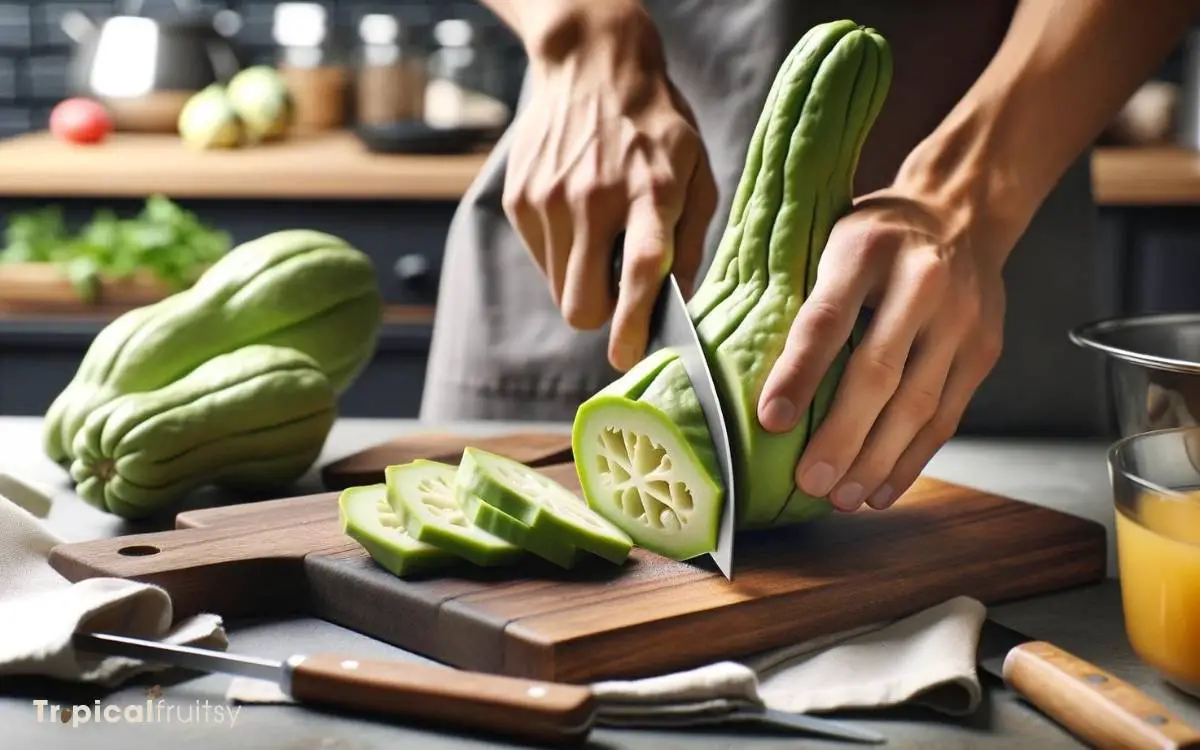How to Cut Chayote Squash? 8 Easy Steps!
To cut a chayote squash, first, wash it thoroughly under running water. Next, use a sharp knife to slice off the ends. You can peel the chayote with a vegetable peeler if you prefer, but it’s not necessary as the skin is edible.
Cut the squash in half lengthwise, revealing the soft seed inside. Remove the seed if desired, and then proceed to slice or chop the chayote according to your recipe needs. Always be cautious when handling the squash as it can be slippery after cutting.
Chayote squash, also known as mirliton, is a versatile vegetable that can be eaten both raw and cooked. It offers a mild flavor and a crisp texture, making it suitable for a variety of dishes, from salads to stews.
When preparing chayote, consider the following:
Enjoy the subtle taste and versatile texture of chayote squash in your next culinary creation by mastering the simple art of cutting it properly.

Key Takeaway
Step 1: Selecting the Right Chayote
Before we dive into cutting, we’ll need to pick out the perfect chayote squash, ensuring it’s firm, unblemished, and vibrant green. It’s crucial to look for a chayote that feels heavy for its size, indicating freshness and good moisture content.
We’ll avoid any with soft spots or wrinkled skin, as these are signs of aging or improper storage. The surface should be smooth or slightly prickly, depending on the variety, but never excessively rough.
We should also check the stem end; it should be intact and free of mold. If we’re planning to consume the chayote soon, we’ll opt for a squash that’s slightly tender when pressed gently—it should yield just a bit under our fingers.
This ensures we’ve got a ripe chayote that’s ready for culinary use.
Step 2: Washing and Preparing
Before we handle our chayote squash, it’s essential we wash it thoroughly to remove any dirt or potential residue.
We’ll then move on to peeling it, ensuring we do so safely to avoid any accidents.
Proper preparation sets the stage for a smoother cutting process and a better cooking experience.
Rinse Thoroughly
We’ll start by giving the chayote squash a good rinse under cold running water to remove any dirt or debris.
It’s crucial to ensure the squash is clean before we proceed with cutting, as any remaining grime can contaminate our food and work surfaces.
Hold the chayote firmly in one hand while you gently scrub its surface with the other, paying close attention to any crevices where unwanted particles might be hiding.
Once we’ve thoroughly washed the squash, we’ll pat it dry with a clean towel. It’s important to dry it well to prevent slipping when slicing.
With the chayote now clean and dry, we’re ready to move on to the next step: cutting it safely and efficiently.
Peel Safely
Peeling the chayote squash is our next step, and it’s essential to do this with caution to avoid any nicks or cuts.
Before we begin, let’s ensure our chayote is properly washed, as we’ve previously discussed.
When handling the chayote, it’s important to note that the skin can be quite tough, and the fruit itself may be slippery. Therefore, we use a sturdy vegetable peeler or a sharp knife.
We steady the chayote on the cutting board and peel away from our hands to maintain safety. It’s also worth mentioning that some people may experience a mild reaction to the sap, so wearing gloves could be advisable.
Let’s move on to discuss the safe peeling techniques that will help us tackle this task with confidence.
Step 3: Safe Peeling Techniques
We’ll now focus on the safe peeling techniques essential for handling chayote squash. It’s imperative to use a sharp peeler to ensure efficiency and reduce the risk of slipping.
Additionally, we must adopt hand protection methods and maintain a stable cutting surface to prevent accidents.
Use Sharp Peeler
Safety is paramount when we’re using a sharp peeler to remove the skin of the chayote squash. A dull peeler can slip and increase the risk of cuts, so we always ensure the peeler is sharp before we begin.
We hold the chayote firmly in one hand, keeping our fingers away from the blade as we peel. With the other hand, we use the peeler, applying steady pressure to remove thin layers of the skin.
This technique reduces waste and preserves more of the flesh for cooking.
We work slowly, maintaining control of the peeler and adjusting our grip as needed to navigate the squash’s contours.
Now, let’s consider hand protection methods to further enhance our safety while handling the chayote.
Hand Protection Methods
Having discussed the importance of a sharp peeler, we now turn to hand protection methods to ensure safe peeling of chayote squash. It’s crucial to guard our hands from potential slips or cuts while handling this firm fruit.
Here’s a table summarizing protective options:
| Protective Gear | Pros | Cons |
|---|---|---|
| Cut-resistant gloves | High safety level | Can be cumbersome |
| Kitchen towel | Improves grip | Less protection |
| Finger guards | Shields specific areas | Limited coverage |
| Bare hands | Full control | High risk of injury |
| Specialized peelers | Built-in safety features | May require practice |
Using cut-resistant gloves offers the most protection, while finger guards provide targeted defense for the most vulnerable areas.
We recommend using these tools, especially for beginners, to minimize the risk of injury while peeling chayote squash.
Stable Cutting Surface
To ensure a secure peeling process, we must work on a stable cutting surface to prevent the chayote from slipping. A steady platform is crucial for safety and precision when handling the firm texture of the squash.
Consider the following tips:
- Place a damp kitchen towel under your cutting board to anchor it in place.
- Opt for a heavy, sturdy cutting board that won’t move around during slicing.
- Keep the chayote dry to minimize slipping; if it’s wet, pat it dry with a paper towel before peeling.
By adhering to these guidelines, we’ll maintain control of the chayote squash, reducing the risk of accidents.
Step 4: Cutting Into Halves
We’ll start by placing the chayote on a cutting board with its stem side facing up. With a firm grip on the squash, we’ll slice it down the middle lengthwise, ensuring we have two equal halves.
This will allow us to handle the chayote more easily in the subsequent steps and also to remove the seed with precision.
To grab your attention, here’s a quick guide:
| Step | Action |
|---|---|
| 1 | Position chayote stem side up |
| 2 | Steady the squash with one hand |
| 3 | Slice lengthwise with a sharp knife |
| 4 | Apply even pressure while cutting |
| 5 | Achieve two equal halves |
With the chayote now halved, we’re ready to move on to removing the seed, which we’ll cover in the next section.
Step 5: Removing the Seed
Removing the seed from each chayote half is our next step, and it’s simpler than you might think. Once we’ve halved the chayote, we’ll see the seed nestled at the center.
Here’s how we’ll proceed:
- Use a spoon: Gently but firmly use the edge of a spoon to pry the seed away from the flesh.
- Apply slight pressure: Press down near the edges of the seed to loosen it without damaging the surrounding squash.
- Lift it out: Once the seed is free, lift it out and discard it.
This process leaves us with a clean cavity, perfect for stuffing or slicing the chayote further. It’s important to be gentle to preserve the integrity of the chayote halves for our recipe.
Step 6: Slicing Techniques
After removing the seed, we can start slicing the chayote into our desired shapes and sizes. For uniform cooking, it’s essential to keep the thickness consistent. We’ll use a sharp knife to ensure clean cuts and reduce the risk of slippage.
For dices, we first slice the chayote into planks, then cut these planks into sticks, and finally cross-cut them into cubes.
If we’re looking for slices, we’ll simply cut the chayote into rounds or semicircles, depending on whether we’ve halved it. Julienne strips require an extra step where we matchstick the sticks obtained from planks.
Regardless of the cut, we always tuck our fingers and use a claw grip to prevent accidents. Each technique contributes to the dish’s texture and aesthetic.
Step 7: Dicing for Recipes
Let’s dive into how to dice chayote squash, a versatile technique that’s perfect for adding texture to a variety of dishes. After peeling and slicing your chayote, it’s time to dice it for recipes like soups, stews, or salads.
Here’s how we do it:
- Lay the chayote flat slices on the cutting board and cut them into strips. Make sure they’re even in width for uniform dicing.
- Turn the strips 90 degrees and cut across them to create cubes. This step is crucial for getting that perfect dice.
- Gather the cubes together and give them a final check, ensuring they’re of similar size for even cooking.
Step 8: Storing Cut Chayote
Once we’ve diced the chayote, it’s essential to store it properly to maintain freshness. To do this, let’s place the cut pieces in an airtight container or a sealable plastic bag.
This reduces exposure to air, which can lead to spoilage. We should also ensure the chayote is dry before storage, as excess moisture can accelerate decay.
If we’re planning to use the chayote within a couple of days, storing it in the refrigerator is suitable.
However, for longer storage, consider blanching the pieces and then freezing them. Blanching halts enzyme actions that can cause loss of flavor and texture.
When we’re ready to use the frozen chayote, there’s no need to thaw it first; it can go directly into the cooking process.
Conclusion
We’ve mastered the art of handling chayote squash, from selection to storage. With careful peeling and savvy slicing, we’ve unlocked its culinary potential.
But let’s keep the anticipation alive; there’s more to chayote than meets the eye. As we tuck it away, fresh for future feasts, we can’t help but wonder: What delightful dishes will we craft next? The possibilities are as tantalizing as they’re endless.
Stay tuned, fellow foodies—our chayote adventure is just beginning.





